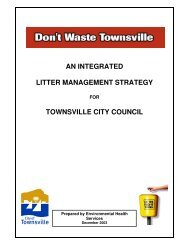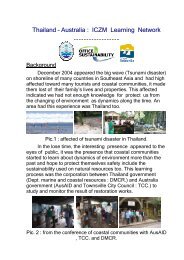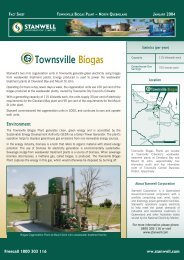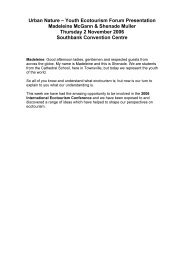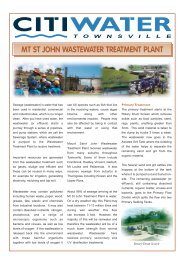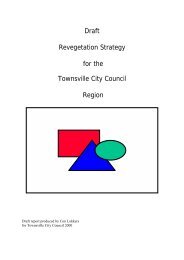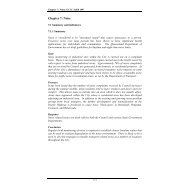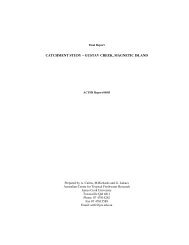ENVI RONMENTAL HI STORY OF ROWES BAY - Townsville State ...
ENVI RONMENTAL HI STORY OF ROWES BAY - Townsville State ...
ENVI RONMENTAL HI STORY OF ROWES BAY - Townsville State ...
- No tags were found...
Create successful ePaper yourself
Turn your PDF publications into a flip-book with our unique Google optimized e-Paper software.
11Environmental history of Rowes Bayinto inner Rowes Bay. The beach here showed no significant build-up of sand from the 1940s to thelate 1990s.Since the Rowes Bay foreshore renourishment project commenced in late 1998, sand has continuedto move south and build-up across the mouth of the creek. However, this build-up now extendssouthwards and a new berm has formed along ~200 m of the inner Rowes Bay beach face.The mouth of One Mile Creek has been a persistent problem area ever since is was constructed in1961. Wave action shifts beach sand southwards, creating a berm landform that rapidly extendsacross the creek mouth and closes it off. This process has continued since the renourishment projectbegan, and was initially reported in the Rowes Bay Renourishment Monitoring Report #2 (p4).The location of the creek mouth seems to be at a critical point in Rowes Bay where the predominantdirection of sand transport by the longshore drift process is to the south. Along the Rowes Bay -Pallarenda foreshore, longshore drift processes move sand to the north and south along the beachface. The dominant longshore drift is to the north (driven by the prevailing southeasterly winds),while smaller amounts of southwards sand movement occurs when winds are from the north,northeast, and east (driven by sea breezes and wet season winds). Inner Rowes Bay is protectedfrom the southeasterly winds by Kissing Point, thus longshore drift tends to occur only to the south.The boundary of this inner Rowes Bay protection zone appears to be somewhere between SiteT30.3 and the mouth of One Mile Creek.6. Natural Environment Changes in Rowes Bay6.1 IntroductionThis section summarises the natural environmental changes that have occurred in Rowes Bay overthe last 135 years. These predominantly relate to changes that have occurred along the foreshore asperiods of accretion and erosion have caused changes in the position of the shoreline. There is littledirect information on shoreline change from before 1938. However, periods of erosion andaccretion can be inferred from climate records of cyclones and floods. From 1938 onwards muchmore information is available from aerial photographs, and other records.6.2 Shoreline Changes in Rowes Bay 1865 - 1938A sketch map of the <strong>Townsville</strong> district from ~1865 shows the Rowes Bay area, but includes littleinformation aside from noting the presence of mangroves in the Mundy Creek catchment. The firstreliable map of the area is a navy hydrographic chart that dates from 1886. This notes that the areaconsists of low sand hills with grass and casuarina trees, and shows a sand spit at the mouth ofMundy Creek. It is ~250 m long and deflects the stream mouth to the NW to the area of the presenttoilet blocks. Bar morphologies are shown offshore from Kissing Point, interpreted as sand beingtransported from the Strand around into Rowes Bay. No other shoreline information is known untilthe first aerial photographs were taken in 1938 (see below). However, possible beach erosion andaccretion can be interpreted from other sources.Shoreline erosion is likely to occur with the passage of cyclones over, or close to the city. Appendix3 lists all cyclones and tropical lows known to have approached within 100 km of <strong>Townsville</strong>. Thelist is doubtless incomplete, but it indicates that in the 73 years up to 1938 there may have been atleast 12 shoreline erosion events (1867, 1870, 1876, 1878, 1881, 1890, 1896 "Sigma", 1903"Leonta", 1910, 1916, 1929, and 1934). Damage to buildings or port facilities were reported for the8 cyclones up to "Leonta" (1903), and beach erosion is very likely to have occurred as well. Theremaining events in the early decades of the twentieth century were apparently much weakersystems, and no reports of damage have been found. Thus, there may have been several decadeswithout significant beach erosion prior to the late 1930s.Episodes of beach accretion in Rowes Bay are much more difficult to infer. Floods in the RossRiver are likely to bring large volumes of sand to Cleveland Bay, but it probably takes somedecades for this sand to be worked along the shoreline into Rowes Bay. After the first breakwaters



